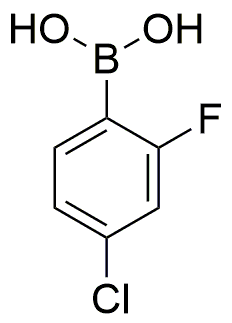4-Chloro-2-fluorophenylboronic acid is widely utilized in research focused on
- Pharmaceutical Development: This compound is crucial in the synthesis of various pharmaceuticals, particularly in the development of targeted cancer therapies. Its ability to form stable complexes with biomolecules enhances drug efficacy.
- Organic Synthesis: It serves as a key reagent in Suzuki coupling reactions, allowing chemists to create complex organic molecules efficiently. This is particularly valuable in the production of agrochemicals and fine chemicals.
- Material Science: The compound is used in the development of advanced materials, including polymers and nanomaterials, which can be tailored for specific applications such as sensors or drug delivery systems.
- Bioconjugation: Its boronic acid functionality enables the selective labeling of biomolecules, facilitating studies in biochemistry and molecular biology, particularly in tracking cellular processes.
- Environmental Chemistry: This chemical can be applied in the detection and removal of pollutants, leveraging its reactivity to bind with harmful substances, thus aiding in environmental remediation efforts.
General Information
Properties
Safety and Regulations
Applications
4-Chloro-2-fluorophenylboronic acid is widely utilized in research focused on
- Pharmaceutical Development: This compound is crucial in the synthesis of various pharmaceuticals, particularly in the development of targeted cancer therapies. Its ability to form stable complexes with biomolecules enhances drug efficacy.
- Organic Synthesis: It serves as a key reagent in Suzuki coupling reactions, allowing chemists to create complex organic molecules efficiently. This is particularly valuable in the production of agrochemicals and fine chemicals.
- Material Science: The compound is used in the development of advanced materials, including polymers and nanomaterials, which can be tailored for specific applications such as sensors or drug delivery systems.
- Bioconjugation: Its boronic acid functionality enables the selective labeling of biomolecules, facilitating studies in biochemistry and molecular biology, particularly in tracking cellular processes.
- Environmental Chemistry: This chemical can be applied in the detection and removal of pollutants, leveraging its reactivity to bind with harmful substances, thus aiding in environmental remediation efforts.
Documents
Safety Data Sheets (SDS)
The SDS provides comprehensive safety information on handling, storage, and disposal of the product.
Product Specification (PS)
The PS provides a comprehensive breakdown of the product’s properties, including chemical composition, physical state, purity, and storage requirements. It also details acceptable quality ranges and the product's intended applications.
Certificates of Analysis (COA)
Search for Certificates of Analysis (COA) by entering the products Lot Number. Lot and Batch Numbers can be found on a product’s label following the words ‘Lot’ or ‘Batch’.
Número de catálogo
Número de lote/lote
Certificates Of Origin (COO)
This COO confirms the country where the product was manufactured, and also details the materials and components used in it and whether it is derived from natural, synthetic, or other specific sources. This certificate may be required for customs, trade, and regulatory compliance.
Número de catálogo
Número de lote/lote
Safety Data Sheets (SDS)
The SDS provides comprehensive safety information on handling, storage, and disposal of the product.
DownloadProduct Specification (PS)
The PS provides a comprehensive breakdown of the product’s properties, including chemical composition, physical state, purity, and storage requirements. It also details acceptable quality ranges and the product's intended applications.
DownloadCertificates of Analysis (COA)
Search for Certificates of Analysis (COA) by entering the products Lot Number. Lot and Batch Numbers can be found on a product’s label following the words ‘Lot’ or ‘Batch’.
Número de catálogo
Número de lote/lote
Certificates Of Origin (COO)
This COO confirms the country where the product was manufactured, and also details the materials and components used in it and whether it is derived from natural, synthetic, or other specific sources. This certificate may be required for customs, trade, and regulatory compliance.


